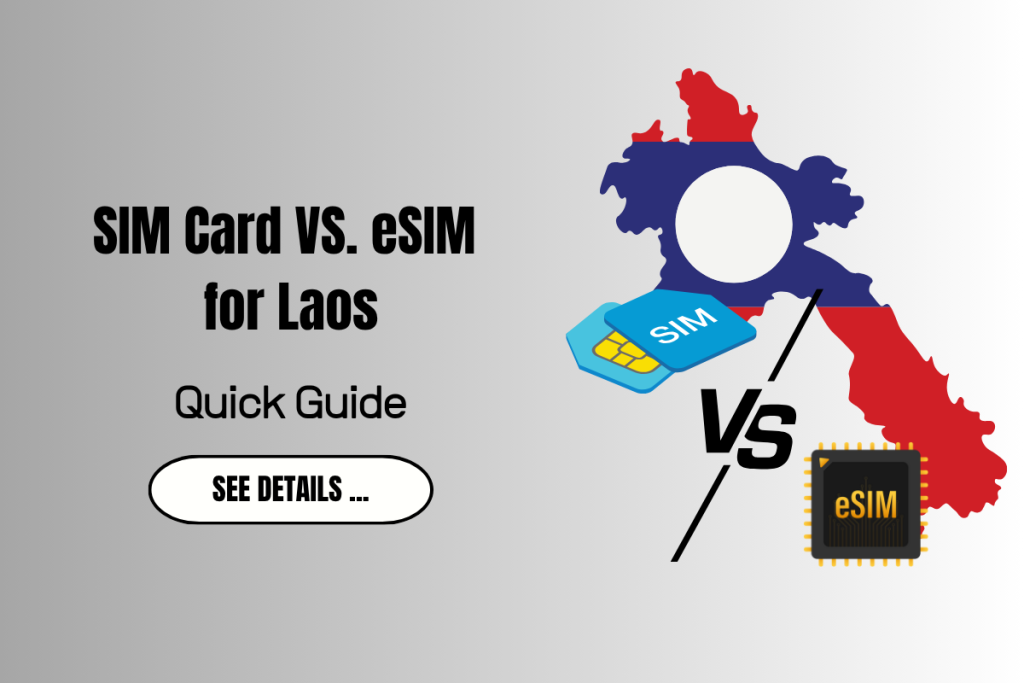The debate between SIM card vs eSIM for Laos travel continues to be relevant for visitors. As you plan your journey through Laos’s stunning landscapes and ancient temples, staying connected is essential for navigation, translations, and sharing experiences. Traditional SIM cards from local providers like Unitel offer familiar reliability, while digital eSIMs provide the convenience of instant activation before arrival. This guide compares both options across price, setup process, and coverage to help you make the right choice for your specific travel needs and device capabilities.

I. What Is a Physical SIM Card?
A physical SIM card is the traditional plastic chip you insert into your phone’s SIM tray. In Laos, you can purchase these from:
- Airport kiosks upon arrival
- Mobile phone shops in cities like Vientiane and Luang Prabang
- Some convenience stores and markets
The process typically involves selecting a provider (Unitel, Lao Telecom, or Beeline are the main carriers), showing your passport for registration, and having a staff member set up your phone. While familiar to most travelers, this process can take 15-30 minutes and requires finding a shop during business hours.
II. What Is an eSIM?
An eSIM (embedded SIM) is a digital version that’s already built into many modern smartphones. Instead of inserting a physical card, you simply:
- Purchase an eSIM plan online
- Receive a QR code by email
- Scan the code with your phone’s camera
- Follow simple activation instructions
The major advantage is that you can set everything up before you even arrive in Laos. When your plane lands, you’ll already have internet access without hunting for a SIM shop or dealing with language barriers. Providers like Laosesim.com specialize in offering eSIMs specifically optimized for travelers to Laos.
III. Device Compatibility: Can You Use eSIM?
Not all phones support eSIM technology. Generally, newer premium smartphones released after 2019 are compatible. These include:
- iPhones (iPhone 11 and newer)
- Samsung Galaxy (S20 series and newer)
- Google Pixel (Pixel 4 and newer)
- Many newer models from Huawei, Motorola, and other manufacturers
Your phone must also be network unlocked to use an eSIM from providers like Laosesim.com. If you’re unsure about your device, most eSIM providers offer compatibility checkers on their websites.
IV. Comparison: SIM Card vs eSIM for Laos
| Feature | Physical SIM | eSIM |
| Setup | Manual, in-store | Instant via QR code |
| Registration | Often requires passport | No ID/verification required |
| Time to activate | 15-30 minutes | Under 5 minutes |
| Availability | Only in Laos | Purchase online from anywhere |
| Risk of losing SIM | Yes | No physical card to lose |
| Multi-country use | Limited | Regional plans available |
| Cost | Varies, can be cheap | Affordable, transparent pricing |
| Hotspot support | Yes | Yes |
This comparison highlights why eSIMs have become increasingly popular among travelers to Laos. The convenience of setting up before arrival and not having to visit a physical store gives travelers more time to enjoy their trip.
V. eSIM – An Alternative Option for Travelers
Laosesim has become a popular choice for travelers to Laos in 2025 because of several key advantages:
- No identity verification or passport uploads required – respecting privacy while simplifying the process
- Affordable plans starting from just $5.50 for 10GB valid for 5 days
- Multi-country options that cover the entire Indochina region in one package
- Instant delivery to your email – purchase minutes before you need it
- 24/7 customer support via WhatsApp for any connection issues
- Wide compatibility with over 200 different device models
Their service connects to the best available networks in Laos (typically Unitel) to ensure reliable coverage throughout the country.
VI. Best eSIM Plans for Laos (via Laosesim.com)
| Plan | Data | Validity | Price |
| Laos eSIM | 10GB | 5 days | $5.50 |
| Laos eSIM | 15GB | 10 days | $6.90 |
| Laos eSIM | 30GB | 15 days | $12.90 |
| Multi-country (Vietnam + Laos + Cambodia + Thailand) | Varies | 8-30 days | From $16.50 |
These plans are designed to match typical travel patterns, with the 10GB/5-day plan being perfect for a short visit to Luang Prabang or Vang Vieng, while the 30GB/15-day option works well for a comprehensive tour of the country.
VII. Conclusion
For most travelers visiting Laos, the decision between a physical SIM and an eSIM comes down to convenience and device compatibility:
If you have a compatible smartphone and value simplicity, an eSIM from laosesim.com offers the best combination of price, speed, and convenience. The ability to set up before arrival and avoid hunting for a SIM shop makes your travel experience smoother from the moment you land.
If you’re using an older phone without eSIM support or need a local phone number for voice calls, a physical SIM from carriers like Unitel still provides good value and reliable service.
The bottom line: Unless you specifically need a traditional SIM, the eSIM option eliminates hassle and gives you more time to enjoy Laos’s stunning landscapes, delicious food, and rich cultural experiences.